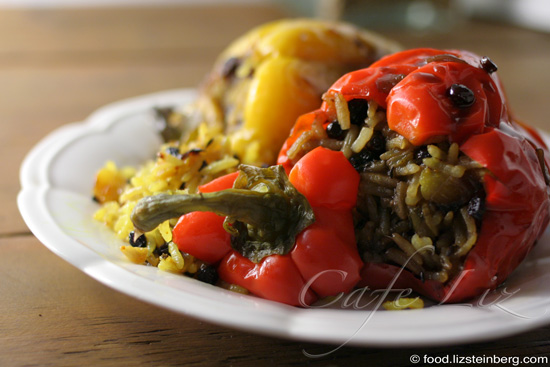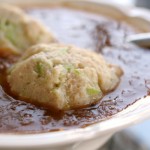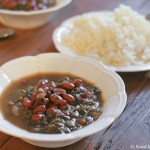
I have a new love. Fortunately, my husband approves, because it’s vegetarian and he can eat it, too.
I’ve been eating my way through the Persian restaurants neighboring the Levinsky market. While the market was originally founded by Balkan immigrants, it now has a strong Persian presence. Among the many bags of beans, grains and dried fruit at the market’s stores, you’ll find plenty of signs in Persian sticking out from among delicacies like jujubes, large dried garlic flakes and dried Persian lemons. If you venture inside and ask the right questions, you can also find industrial quantities of Basmati rice, saffron and roasted chickpea flour.
This makes it the most natural of places to seek out a good Persian meal, and indeed, there are three lunchtime restaurants within spitting distance on Nahalat Binyamin — Salimi, Nebayev and Shimshiri. All are kosher and operate from about noon to 5 P.M. on weekdays, and all offer classics such as ghormeh sabzi (a herb-filled stew with kidney beans), gondi (chicken-chickpea dumplings in a clear yellow chicken broth) and grilled meat in saffron, with heaping plates of fresh herbs on the side. At all, you’ll pay 30 to 40 shekels per meal, depending how much you order.
Salimi, at Nahalat Binyamin 80, is by far the best-known of the bunch. It also has the most limited selection — just sabzi, gondi and grilled meats. There’s also no written menu. I particularly liked the gondi, in its rich chicken broth.
Nebayev, at Nahalat Binyamin 78, is larger than its neighbor Salimi, and offers at least half a dozen Persian stews and several kinds of rice. It’s also the only one of the three to have an orderly menu with descriptions and prices. I particularly liked the beef stewed in fruit and the yellow rice speckled with mini-raisins (which I tried to recreate — see recipe below). Lunch is 42 shekels for a meat dish, a rice dish and free helpings of salads. If you ask nicely, they’ll give you a bowl of sauce and vegetables from one of the other meat dishes, too (read: these vegetable dishes are obviously not meat-free).
Shimshiri, at Nahalat Binyamin 99, is by far the most vegetarian-friendly of the crew, and was able to offer us meat-free sabzi, beet stew with rice and the most amazing stuffed peppers I’ve ever had (remember the love I mentioned?). It has some form of printed menu, but no prices. The dishes we ordered ranged between 30 and 35 shekels each, and chopped salad is on the house.
View Persian restaurants in the Levinski market in a larger map
So, you can guess where this is heading. Shimshiri’s stuffed peppers are to die for, and I was determined to make my own. And, come to think of it, Nebayev’s raisin rice was quite good, too — so why not attempt to combine the two?
The following recipe draws on the flavors in Shimshiri’s sauce, and takes some of the seasonings from Nebayev’s rice and mixes them with what I tasted in the original stuffed pepper fillings.
These quantities make twice as much rice as you’ll need to fill the peppers. As you can see, I served the extra rice alongside them. (You could also choose to double the number of stuffed peppers.)
These miniature raisins (possibly also known as currants — thanks, Molly) are less than half the size of regular raisins, and can be found at most local stores and markets selling dried fruits. Due to their delicate size, they pair better with the rice grains than regular raisins. If you can’t find them, you could just take regular raisins and chop them roughly.

For six stuffed peppers plus another two cups of cooked rice:
For the rice:
- 2 cups Persian rice
- 1/4 cup oil
- 1 onion
- 6 garlic cloves
- 1 teaspoon whole cumin seeds
- 3/4 cups miniature raisins (currants)
- 1/4 cup dried apricots, chopped finely
- 2 teaspoons chopped fresh mint (or 1/2 teaspoon dried mint)
- 1/2 teaspoon salt
- 2 teaspoons turmeric
For the stuffed peppers:
- 6 small or medium-sized peppers
For the sauce:
- 1 onion
- 2 garlic cloves
- small amount of oil (±1 tablespoon)
- 3-4 dried apricots
- 1 tablespoon raisins
- 1/2 cup pomegranate syrup
- 2 teaspoons tamarind paste
- 1/4 teaspoon salt or to taste
First, start the rice: We’re making it Persian style, which means immersing it in lots of water (at least 4 cups) in a pot, bringing to a boil and simmering for 8-10 minutes. At this point, the rice should be mostly but not fully cooked. Dump the mostly-cooked rice into a strainer to remove the remaining water, and let drain.
Chop the onions, garlic and apricots. Put 1/4 cup oil into a pot — the same pot, if you like — and add the onions. Let them brown on a low flame. Once the onions are soft and golden, add the garlic and the cumin. The cumin seeds may start popping out of the pot as they toast in the oil, so beware.
Turn off the heat, add the raisins, apricots, mint, salt and turmeric to the pot, and mix the rice back in. Mix until the seasonings are well-incorporated into the rice.
Meanwhile, make the sauce: Chop the onions, garlic and apricots. Add a small amount of oil to a pot large enough to fit the six peppers, and on a low flame, brown the onions for the sauce. Once the onions are golden, add the garlic and brown as well. Add the remaining sauce ingredients along with a bit of water — about 1/4 cup, or as much as you want to get the consistency you desire. Turn off the heat until you’re ready to add the peppers.
Now, stuff the peppers: Cut the tops off the peppers and remove the seeds from inside (you can keep the tops to put back on the peppers, for the sake of presentation). Spoon rice into the peppers until they are mostly full — the rice won’t gain much more volume, since it’s nearly cooked — but don’t pack too tightly. Arrange the peppers with the cut sides pointing up in the pot, and spoon a few teaspoons of gravy onto the top of each pepper (you can now stick the pepper tops back on them, if you want). Cover the pot, turn the flame back on and bring to a simmer. Cook until the peppers are soft.
To finish the rice: Add 2-3 tablespoons of water to the pot with the rice, cover and cook on a low flame for a few more minutes, until the rice is fully cooked.
Serve the peppers alongside the extra rice and sauce.





